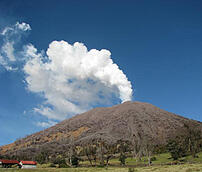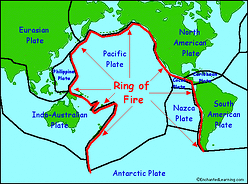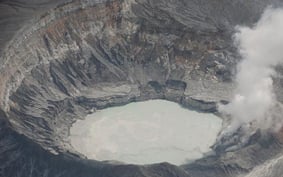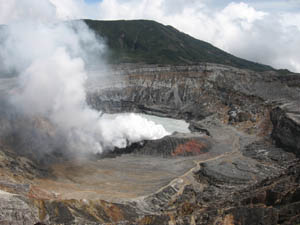Looking for a gem of an area for adventure travel and eco-tourism? You need look no further than the Pacific’s Ring of Fire, and Costa Rica is one of its greatest jewels.
 The Ring of Fire draws its name from the fiery volcanic activity that takes place around much of its edge. Its arc of intense volcanic and seismic activity stretches roughly around the Pacific Ocean from New Zealand, along the eastern edge of Asia, north across the Aleutian Islands and down along the North and South American coasts. Oceanic trenches and volcanic arcs and belts mark its edges. The Ring of Fire is home to 452 volcanoes, over 75% of the world’s most active and dormant volcanoes.
The Ring of Fire draws its name from the fiery volcanic activity that takes place around much of its edge. Its arc of intense volcanic and seismic activity stretches roughly around the Pacific Ocean from New Zealand, along the eastern edge of Asia, north across the Aleutian Islands and down along the North and South American coasts. Oceanic trenches and volcanic arcs and belts mark its edges. The Ring of Fire is home to 452 volcanoes, over 75% of the world’s most active and dormant volcanoes.
 The cause of the Ring of Fire’s volcanic and seismic activity can be explained by plate tectonics. Scientists believe the Earth’s surface is broken into shifting slabs, or plates, that have been in motion since Earth’s beginnings. The plates move away from, collide with, slide across, and subduct other plates. This amazing force of nature has formed and split continents, carved ocean trenches, and created magnificent, and often volcanic, mountain ranges.
The cause of the Ring of Fire’s volcanic and seismic activity can be explained by plate tectonics. Scientists believe the Earth’s surface is broken into shifting slabs, or plates, that have been in motion since Earth’s beginnings. The plates move away from, collide with, slide across, and subduct other plates. This amazing force of nature has formed and split continents, carved ocean trenches, and created magnificent, and often volcanic, mountain ranges.
While these can be found all across the Ring of Fire, the forces of nature collide magnificently in Costa Rica, a jewel on the Ring of Fire. The interplay of the Cocos and Carribean plates combined with the central location between North and South America has resulted in a land of staggering diversity of terrain and biodiversity. Costa Rica is blessed with mountains that meet the sea on its Pacific Coast, a direct result of the energy created as the denser Cocos Plate subducts (drives beneath) the lighter Caribbean Plate that much of Central America rests upon.
 Costa Rica is a land of sweeping panoramas and has four great mountain ranges, two of which are volcanic in nature—molten magma, volcanic ash, and gases escape through ruptures in the planet’s surface. The Guanacaste Volcanic Range, 112 kilometers long, and the Central Volcanic Range, 76 kilometers long are exciting attractions for scientists and tourists alike and are visited by more people than any other volcanoes in Central America. While the peaks and craters of active volcanoes may resemble the dusty desolation of the moon’s surface, the lower slopes and fertile land surrounding the volcanoes have been nurtured over time by volcanic ash and is home to lush, green rainforests and farmland.
Costa Rica is a land of sweeping panoramas and has four great mountain ranges, two of which are volcanic in nature—molten magma, volcanic ash, and gases escape through ruptures in the planet’s surface. The Guanacaste Volcanic Range, 112 kilometers long, and the Central Volcanic Range, 76 kilometers long are exciting attractions for scientists and tourists alike and are visited by more people than any other volcanoes in Central America. While the peaks and craters of active volcanoes may resemble the dusty desolation of the moon’s surface, the lower slopes and fertile land surrounding the volcanoes have been nurtured over time by volcanic ash and is home to lush, green rainforests and farmland.
Whether you want to get a close view of the Ring of Fire and the creation of the earth’s crust, tour one of the nations many active and dormant volcanoes. Three fine examples are Poás, Irazú, and Arenal.
 Poás, located in the Central Volcanic Range, is one of the most spectacular volcanoes. The mile-wide crater of the volcano and its national park highland forests attract scientists and tourists from around the world. The volcano has often been referred to as the world’s largest geyser due to its geyser-like eruptions of gas and ash. The area around the crater is barren, but thick vegetation, the cold water Botos Lake, and the gorgeous La Paz Waterfall are all wonderful park features and activities like bird-watching, horseback riding, hiking, camping, and fishing abound.
Poás, located in the Central Volcanic Range, is one of the most spectacular volcanoes. The mile-wide crater of the volcano and its national park highland forests attract scientists and tourists from around the world. The volcano has often been referred to as the world’s largest geyser due to its geyser-like eruptions of gas and ash. The area around the crater is barren, but thick vegetation, the cold water Botos Lake, and the gorgeous La Paz Waterfall are all wonderful park features and activities like bird-watching, horseback riding, hiking, camping, and fishing abound.
Irazú, the “mountain of thunder” is also located in the Central Range, north of Cartago, the former capital of Costa Rica. During its last incredible eruption between 1963-1965 it showered Costa Rica’s Central Valley in ash, a boon for the farming industry. Irazú, nearly 200 square miles, is the largest volcano and the tallest at 11,260 feet. On a clear day you can see both the Atlantic and Pacific oceans from its summit. The main crater is accessible by walking across the lunar-like surface of “Hermosa Beach” but primary forest surrounds Irazú’s lower slopes.
Arenal is a “textbook” volcano with a perfect cone that spews red hot rocks from its peak. It is located in the Guanacaste Range and borders on old forests. Arenal Lake provides activities and adventure for nature enthusiasts. A few of the many activities to pursue there are wind-surfing, fishing, boating, horseback riding, hinking, camping, and swimming. Arenal’s last eruption was in 1968, but it remains active. Steaming flows of andesite lava can be seen meandering from one of its craters during the day. At night Arenal, one of the crown jewels of Costa Rica and the Ring of Fire, has been known to sparkle as it puts on a show. Arenal’s emissions create red streams of light which soar upward into the night sky like fireworks. There is so much more to experience in Costa Rica, a small, but spectacular gem along the Ring of Fire.
Pacific Lots of Costa Rica is a sustainable international residential development located on the southern Pacific coast of Costa Rica. Now in our 22nd year, we sell home sites and build custom homes.


